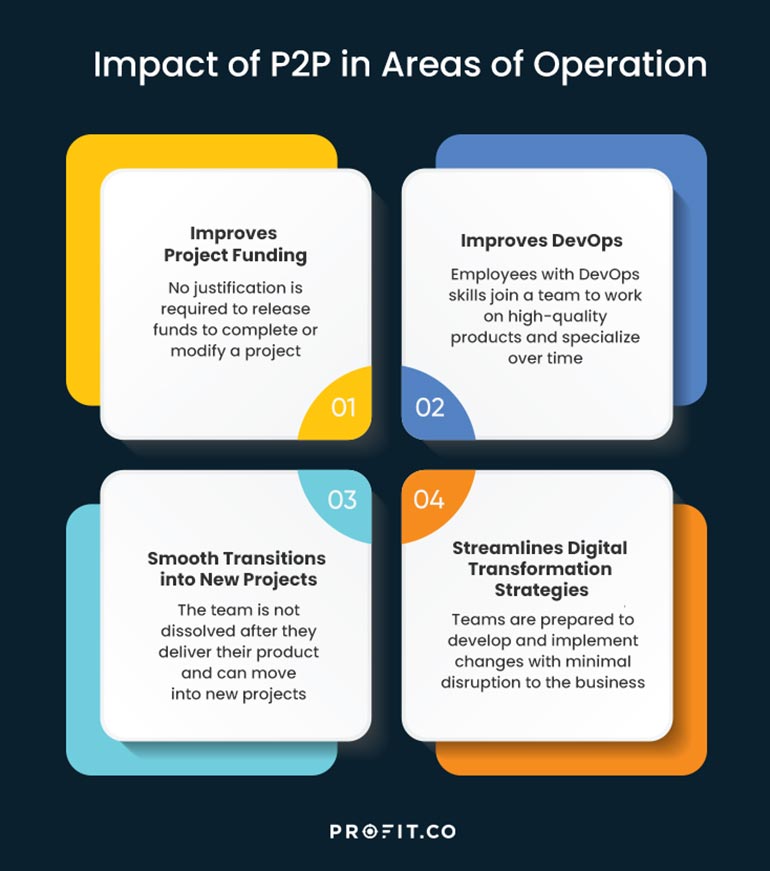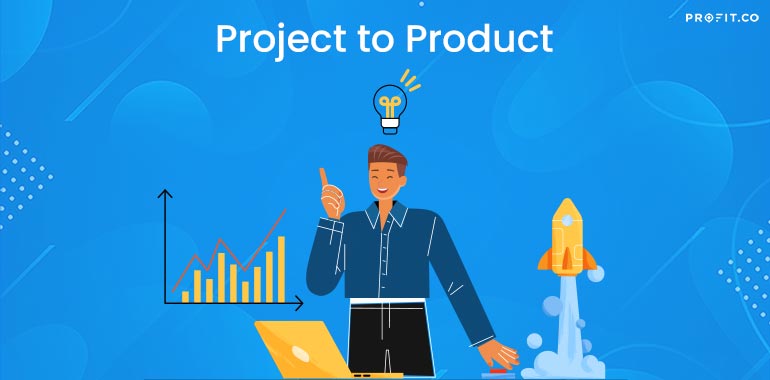Introduction
The mindset shift from project to product is the new trend in the DevOps and digital transformation world. Any organization that creates products or services can benefit from this innovative approach to development.
A project to product mindset (P2P) affects every business element, from developing agile workflows to budgeting and customer service. But what exactly is a project to product, and how does it influence your business?
This guide breaks down this concept with practical examples, so let’s dive in!
Differences Between Project and Product
The first step is to define what is a project and a product. A project is a temporary task conducted within a specific period, using particular resources to deliver an expected result or outcome.
For example, building a house is a project: you’ll need a budget for materials, labor, and a time frame up until the move-in day. The project ends once construction is complete. When the homeowner needs further improvements or renovation, they must find another contractor or rehire the original builders with a new budget and delivery time.
On the other hand, a product is a commodity that satisfies a consumer’s needs. A product’s features, use, and benefits justify its existence in the market. A product also undergoes changes and improvements to keep it relevant as consumer needs evolve.
In the above example, a house is a product that needs regular maintenance and renovations to keep it functional and increase its value as an investment. These activities continue long after construction is over.
You can get started on Profit.co for free and see how OKRs can help close the gap in execution when you sign up today!
How Does A Project Mindset Work?
A project mindset is more focused on operations to develop a product. Say a company takes on an e-commerce project for a small business. A team leader is in charge of the project and assigns developers to work on various sections, such as UX/UI, automation, etc. Once the e-commerce solution is complete, ownership moves to the business that uses it for its online shop.
Note that a project-oriented business requires a written business case, budget negotiations, and fixed deadlines to deliver a solution. A project mindset can utilize agile techniques and strategies to streamline development.
Benefits and Problems with The Project Approach
The benefits of the project approach include:
- Prioritized delivery by meeting a clear budget and deadline.
- Managing one solution at a time, then handing it over upon completion.
- Giving variety and creativity for teams to stay motivated.
The downsides of the project approach include:
- Bottlenecks, whenever a project needs changes, goes over or under budget, or exceeds the deadline.
- Need for justification for additional resources to complete the project.
- Mismanaged resources if the project finishes under budget.
What Is the Product Mindset?
A product mindset relies on a reliable development team to own a solution for its entire lifetime. Using the e-commerce solution example, a product-oriented DevOps team is responsible for getting the online shop to the launch date and for any required troubleshooting, maintenance, and upgrades for the solution.
This long-term ownership keeps your team motivated and committed to the solution’s success, rather than aiming for an end date and moving on to the next project.
Of course, project to product teams can handle multiple projects at once. The difference is in how they handle upgrades and changes. A project-minded team needs to begin a renegotiation process to justify additional resources.
A product-minded team adds the enhancements to their ongoing schedules since they don’t alter their resource allocation. When a client needs an urgent change to their solution, the DevOps team prioritizes them over their other tasks without missing a step.
Quality is never an accident. It is always the result of intelligent effort.
Advantages of Product Mindset
A product mindset offers several benefits to an organization:
- A DevOps team owns a product, is responsible for product performance and ensures its long-term success, meaning they’re fully engaged and motivated to create high-quality solutions.
- A project to product mindset also creates a sense of job security such that developers know that they’re responsible for the solutions long after they go to market.
- A product mindset reduces the operational time since there’s no need to establish a new project team every time the solution needs a change.
- Product teams also break down the solution into actionable tasks, which lead to faster production and delivery time.
- A long-standing product team also has no dips in productivity when developing their solutions. They already know what the solution requires and are ready to adapt to change.
Project to Product Approach
To adapt to the project to product mindset in your organization, consider the key challenges below:
- A shift from time-bound project teams which dissolve upon delivery to a steady, multi-tasting development team with long-term objectives.
- Shift from measuring project outputs to measuring project objectives and outcomes.
- Shift from a waterfall development strategy to a faster, agile approach based on communication and feedback.
- Shift from focusing on the bottom line to partnership and client satisfaction.
This mindset change represents a new way of working, which raises questions and concerns at all organizational levels. Discuss the project to product journey with your teams in detail to ensure everyone remains onboard with your vision.

Steps in Transforming from Project to Product
The belief in constant creation and modification is at the heart of the project to product mindset. When an organization shifts from project to product, it changes how they recruit, budget, distribute resources, and build relationships with its clients. Here are some essential steps to begin your project to product journey.
Step 1: Know Your Products
Your products may be internal solutions for your company or external solutions for your clients. The P2P process works whether you have a single product or thousands in your portfolio. Either way, identify which products you’re actively working on and bring every stakeholder in agreement.
Step 2: Choose Your Teams
Your teams will most likely dissolve after completing their projects, so the next step is to modify your teams for long-term sustainable work. The project to product mindset moves projects to established groups rather than moving teams to projects. The DevOps team can partner with your customer service and call center to handle client queries. Your developers remain responsible for their products and dissolve the team if their product reaches its end of life. Managers can share the productivity appraisal comments with the DevOps teams
Step 3: Know Your Product’s True Cost
Look at your solutions in detail to understand each feature, skill set, and resource required to create and maintain it. Now, place a monetary value on these points to see if they align with your budget. Adjust your product development process to match budget categories to deliver the maximum value for your business and clients.
Step 4: Choose A Small Project
Any organizational change puts significant strain on the business. what is project planning? Begin with a low-impact project to experiment with the project to product journey. Choose a team of about 12 people to manage financing and prioritization as the product crosses its production milestones. Use this experience to scale up and include more products, larger teams, and budgets.
Step 5: Make Continuous Improvements
Use kanban boards or other task management techniques to identify bottlenecks as you move from project to product. Place these tools in a high-traffic area on your business premises, and make it accessible to all management levels. This way, you can share your progress transparently and gather feedback on how to improve your project to product journey.
Impact of P2P In Various Areas of Operation
- P2P improves project funding since new work becomes part of the backlog. It no longer requires a justification process to release funds to complete or modify a project.
- P2P improves DevOps by making it a skill rather than a job title. Team members with DevOps skills join a team to work on high-quality products and specialize over time.
- P2P enables smooth transitions into new projects since the team doesn’t dissolve after they deliver their product. Instead, they receive new work while overseeing previously completed products.
- P2P streamlines digital transformation strategies because teams are prepared to develop and implement changes with minimal disruption to the business. You don’t need to assemble a new group dedicated to digital transformation; instead, assign this task like any other product.
FAQs
What is a project to product?
Project to product is an approach to digital development that shifts your focus from typical project management to value addition.
What’s the difference between project and product?
A project is a task with predetermined resources and time limits to deliver a finished commodity. A product is a practical problem-solving good or service relevant in the marketplace.
Why should companies move from project to product?
The project to product mindset streamlines your workflows, utilizes resources effectively, and keeps both your teams and clients highly engaged.
Conclusion
A project to product mindset is precisely what you need to improve your digital transformation initiative. Like any other organizational culture change, P2P takes time, effort, and transparency to implement. Onboarding the tried and tested OKR methodology can ensure the success of the digital transformation strategy. There are OKR examples for project managers that can be used as a reference to set the OKRs for a successful project to product workflow. You can improve the chances of your project to product journey using Profit.co OKR software. This solution helps you track and execute your business tasks and improve P2P execution in your business. Contact us today for a free demo to learn how OKR software transforms your business from project to product.

